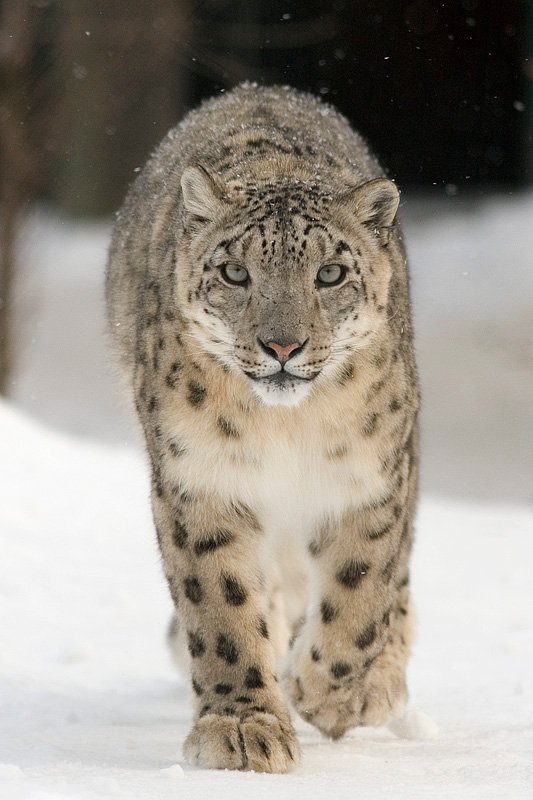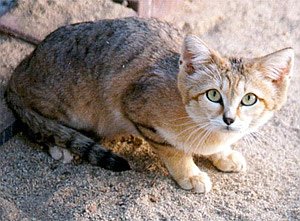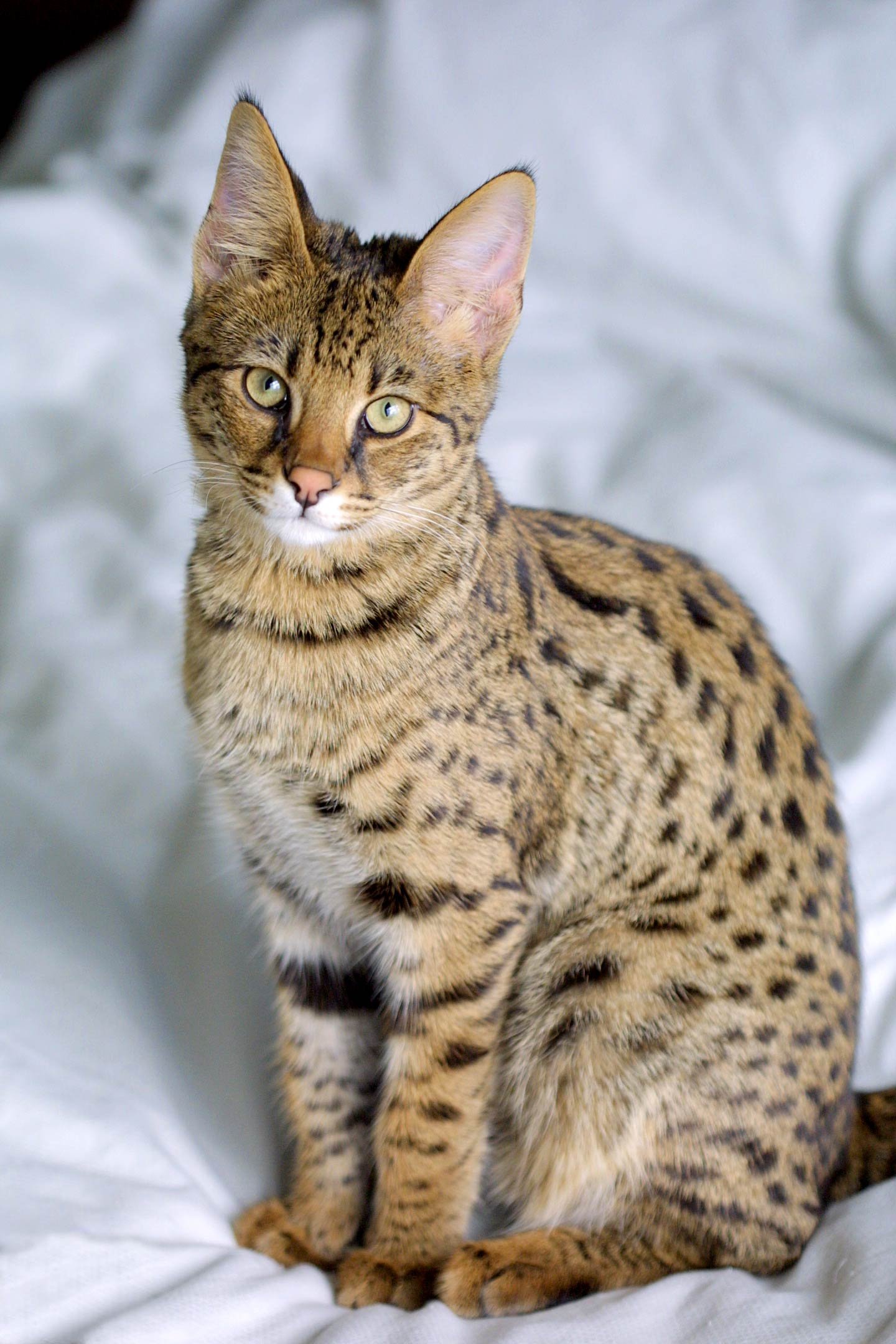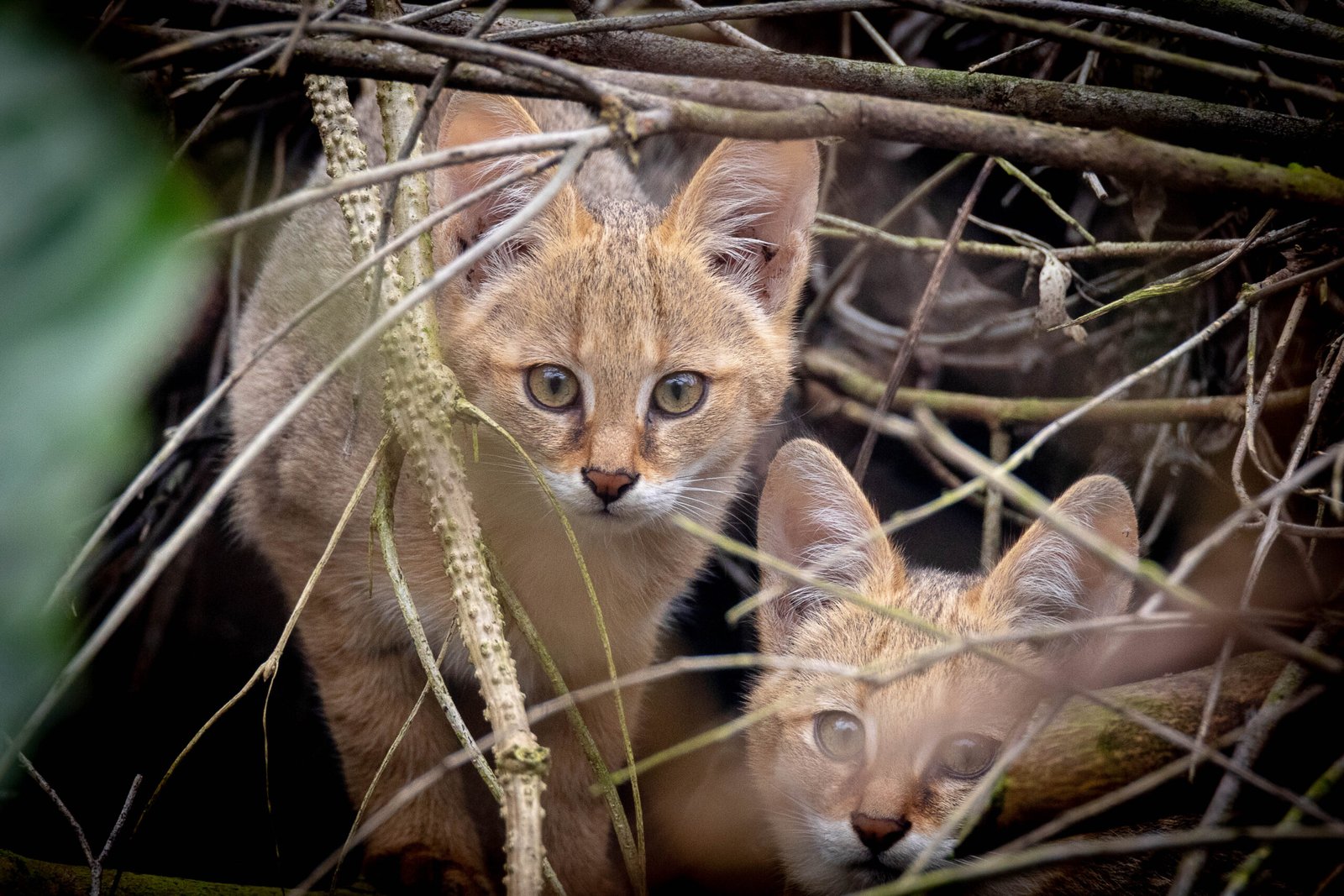Ever think all big cats prowl through tangled jungle vines? Think again! Some of the world’s most fascinating felines rule deserts, mountains, grasslands, and icy forests—far from any steamy rainforest. Get ready to meet the wild wonders that prove “jungle cat” is just one chapter in the big cat story. Let’s take a closer look at 25 captivating facts and faces from the untamed side of the feline family!
The Mighty Lion: King of the Savannah

Lions might be dubbed the “kings of the jungle,” but their true domain lies in the vast, open savannahs of Africa. Living in closely bonded prides, they rule the grasslands with thunderous roars and coordinated teamwork. Their tawny coats act as perfect camouflage among the golden grasses, helping them stalk prey with stealth and precision. Beneath acacia shade or beneath the stars, lions reign where the horizon stretches wide and wild.
The Snow Leopard’s Chilly Kingdom

Snow leopards are elusive masters of the mountains, perfectly adapted to the rugged terrain of Central Asia’s high-altitude wilderness. Their dense, smoky-gray fur insulates them against biting cold, while their long, powerful tails aid in balance as they bound effortlessly across steep, icy cliffs. Blending seamlessly into the snow-covered rocks, they move like phantoms—rarely seen, but deeply revered. These “ghosts of the mountains” embody a quiet strength that captivates all who glimpse their world.
Cheetahs: The Speed Demons of Open Plains

No dense jungle can match the cheetah’s craving for speed and space. Built for explosive acceleration, these sleek predators rule the open plains, using their long legs, flexible spines, and distinctive black “tear marks” to track and outrun prey with astonishing precision. Reaching speeds up to 70 mph, they’re nature’s sprinters—more at home in grasslands than in tangled forests. Their world is all about the chase, not the climb.
Pumas (Mountain Lions) Roam the Americas

Known as cougars, mountain lions, or pumas, these elusive cats are among the most adaptable predators in the Western Hemisphere. From the icy slopes of the Rockies to scorching desert canyons, they thrive across a vast range of habitats—just not jungles. Solitary by nature, pumas rely on stealth, strength, and jaw-dropping agility, with the power to leap 18 feet vertically or cover 40 feet in a single bound. They’re the silent athletes of the wild, built for both grace and grit.
The Elusive Eurasian Lynx

Eurasian lynx are masters of quiet pursuit, navigating dense forests and snowy landscapes with near-ghostly silence. Their tufted ears enhance hearing, while their dappled coats blend seamlessly into underbrush and winter terrain, making them nearly invisible to prey. Unlike big cats that chase, lynx rely on patience and precision, often staying motionless for hours before springing into action. Their world is one of shadow, stillness, and sudden, breathtaking power.
The Desert’s Secret: The Caracal

Sporting tall, tufted ears and a sleek cinnamon coat, the caracal is built for stealth and speed in arid landscapes, not steamy jungles. These agile hunters are famed for their gravity-defying leaps, able to launch straight into the air to pluck birds in flight with astonishing accuracy. Their powerful hind legs and keen reflexes make them dryland acrobats, perfectly suited to open savannahs and desert scrub. Stylish and deadly, the caracal is as bold as it is elusive.
Tigers in Mangroves and Grasslands

Tigers may be symbols of dense jungle power, but their adaptability stretches far beyond the forest. Bengal tigers, for instance, navigate the tangled waterways of the Sundarbans with ease, swimming between mangrove islands and hunting in swampy grasslands. Their strength and stealth carry them through a wide range of habitats—from tropical forests to snowy mountains. Wherever they roam, tigers prove they’re not just iconic—they’re incredibly versatile survivors.
The Canadian Lynx: Snowshoe Specialist

The Canadian lynx is a true winter specialist, perfectly adapted to thrive in icy, snow-covered wilderness. Its oversized, fur-covered paws spread weight evenly, allowing it to glide effortlessly across deep snow—much like a natural pair of snowshoes. With keen night vision and acute hearing, it silently stalks snowshoe hares, its primary prey, through dense boreal forests. Draped in a silvery coat that blends seamlessly with its frosty surroundings, this elusive hunter is a ghost of the northern wild.
The True Leopard: Master of Many Habitats

Leopards are the stealthy survivalists of the cat world, thriving in habitats from open savannahs to mountainous terrain—and only occasionally venturing into jungles. Their incredible adaptability allows them to coexist with a range of environments and prey, making them one of the most widespread big cats. Known for their solitary nature and unmatched strength, leopards can haul kills far heavier than themselves into trees, safely out of reach of scavengers. Quiet, powerful, and endlessly resourceful, they’re the definition of feline versatility.
Servals: Tall-Eared Grassland Hunters

Servals are elegant hunters of African wetlands and grasslands, instantly recognizable by their long legs, sleek spots, and oversized ears. Those ears aren’t just for show—they allow servals to detect the faintest rustle of prey hidden beneath grass or soil. Their vertical leaps, reaching up to 10 feet high, are both dazzling and deadly, letting them snatch birds midair or surprise rodents from above. With a mix of grace, precision, and playfulness, the serval turns every pounce into a performance.
The Ocelot: Spotted Night Stalker

Ocelots are secretive and striking, gliding through the dense forests and tangled scrublands of South and Central America with feline finesse. Their intricately patterned coats offer perfect camouflage in shadowy undergrowth, where they hunt and explore mostly under the cover of night. Agile climbers and skilled swimmers, they navigate their world with quiet confidence. Though elusive in the wild, their bold curiosity and mesmerizing eyes leave a lasting impression wherever glimpsed.
The Manul (Pallas’s Cat): Grumpy Face of the Steppes

Pallas’s cats, or manuls, are solitary survivors of the harsh Central Asian steppes, perfectly adapted to cold, open landscapes. Their flattened faces and stocky builds give them a comical, perpetually grumpy look, but every feature serves a purpose—from thick fur that insulates against freezing winds to low-slung bodies that blend into rocky terrain. Unlike tree-climbing cats, they prefer creeping between stones and shrubs, using stealth over speed. With wide-set eyes and an unmatched scowl, they’re unmistakably one of nature’s quirkiest felines.
The Jaguarundi: The Weasel Cat

Jaguarundis break the feline mold with their slender frames, short legs, and smooth, unspotted coats that come in shades from gray to reddish-brown. Unlike their flashier relatives, they move low to the ground, weaving through brush and grasslands with stealth and speed. Their otter-like appearance and secretive nature make them masters of going unnoticed. Adaptable and elusive, jaguarundis are quiet prowlers of open spaces rather than dense jungles.
The Cheetah’s Cousin: The African Golden Cat

The African golden cat is a solitary shadow of Africa’s dense rainforests and misty highlands, moving silently through undergrowth few humans ever tread. Though rarely spotted, it’s known for its muscular build and striking coat, which ranges from rich gold to gray, often with subtle spotting. This secretive feline is so elusive that much of its behavior remains a mystery, even to researchers. In the filtered forest light, its gleaming fur and quiet grace make it a true phantom of the wild.
The Ghost of the Andes: The Andean Mountain Cat

The Andean mountain cat is one of the rarest and least-known wild cats on Earth, dwelling in the remote, wind-swept heights of the Andes. With thick, silvery-gray fur and a boldly ringed tail, it blends perfectly into the rocky slopes it calls home. Adapted to freezing altitudes and scarce prey, this feline is a master of survival in one of the planet’s harshest environments. Spotting one in the wild isn’t just lucky—it’s legendary.
The Sand Cat: Desert’s Cutest Survivor

Sand cats are desert dynamos, built to thrive where few other creatures dare to roam. Their wide-set ears help detect the faintest sounds of underground prey, while thick fur on their paws protects them from scorching sand. Despite their sweet, kitten-like appearance, they’re fierce and fearless hunters—taking down venomous snakes and rodents with ease. Perfectly adapted to arid extremes, sand cats are tiny titans of the world’s harshest landscapes.
The Bobcat: North America’s Feline Phantom

Bobcats are the ultimate North American survivors, equally at home in dense woods, dry deserts, or the fringes of human neighborhoods. With their short, bobbed tails and tufted ears, they cut a distinctive figure as they move with stealth and purpose through varied terrain. Solitary and self-reliant, bobcats rely on sharp senses and adaptability to hunt everything from rabbits to rodents. Whether in the wild or near the city, they quietly command the landscapes they roam.
The Jungle’s Distant Cousin: The Fishing Cat

Fishing cats are the wetland specialists of the feline world, perfectly built for life along rivers and mangroves in South Asia. With partially webbed feet, dense water-resistant fur, and a powerful build, they wade and dive with ease—turning fish into fast food. Unlike their land-loving cousins, these cats don’t just tolerate water—they embrace it. If domestic cats had a fishing league, the fishing cat would be their fearless, finned coach.
The African Wildcat: Ancestral Adventurer

The African wildcat is the unassuming origin of today’s domestic cat—stealthy, resourceful, and fiercely independent. With its sandy coat and faint stripes, it blends seamlessly into the dry grasses of Africa’s savannahs, where it hunts under the cover of twilight. These solitary hunters rely on keen hearing and patient precision, traits passed down through generations to our feline companions. Though humble in appearance, the African wildcat is the blueprint of the housecat’s wild heart.
The Rusty-Spotted Cat: Tiny but Mighty

The rusty-spotted cat may be tiny, but it packs all the instincts of a top predator into its pocket-sized frame. Weighing as little as two to four pounds, this agile feline prowls India’s forests and grasslands with silent precision, often darting up trees or slipping through underbrush in search of prey. Its large, expressive eyes and delicate spots give it an endearing, kitten-like appearance—but don’t be fooled. Behind that charm lies a wild, fearless hunter.
The Carpathian Lynx: Eastern Europe’s Stealthy Hunter

The Carpathian lynx is a powerful yet elusive predator, perfectly adapted to the rugged forests and snowy peaks of Eastern Europe. Its dense coat and broad, fur-covered paws act as natural snow gear, allowing it to move silently through deep drifts in search of prey. Solitary and stealthy, it prefers remote wilderness far from human eyes—making encounters vanishingly rare. In the quiet heart of the Carpathians, this lynx reigns as a ghost of the winter woods.
The Arabian Leopard: Desert Ghost

The Arabian leopard is a rare and elusive predator, perfectly adapted to the arid, rugged landscapes of the Arabian Peninsula. With a pale, spotted coat that blends into rocky cliffs and desert scrub, it moves silently through one of the world’s harshest habitats. Smaller than other leopards, it survives through sheer stealth, solitude, and an uncanny ability to disappear into its surroundings. As one of the most endangered big cats on Earth, its survival is both a challenge and a symbol of wild resilience.
The Margay: The Acrobat of the Trees

Margays are agile acrobats of the treetops, earning their nickname “monkey cat” thanks to their remarkable climbing skills and arboreal lifestyle. With ultra-flexible ankles that rotate up to 180 degrees, they can descend trees headfirst and leap from branch to branch with ease. Unlike many other wild cats, margays spend nearly all their time above ground, hunting, sleeping, and navigating their leafy world. Their life aloft is a masterclass in balance, stealth, and feline finesse.
The Jungle Cat (But Not From Jungles!)

Despite its misleading name, the jungle cat thrives not in dense forests but in open habitats like wetlands, grasslands, and reed-filled riverbanks across Africa and Asia. Its long legs, lean build, and tawny coat help it blend effortlessly into dry vegetation, where it stalks prey with quiet precision. Equally comfortable in water, this feline is a skilled swimmer—often seen prowling near lakes and marshes. Agile and adaptable, the jungle cat is a master of survival beyond the jungle.
The Black-Footed Cat: Africa’s Tiny Terror

The black-footed cat may be tiny—barely bigger than a housecat—but it’s one of the most efficient predators on the planet. Weighing as little as two pounds, it stalks the dry savannah with relentless energy, taking down dozens of prey each night with astonishing success. Its bold, no-nonsense attitude has earned it a fierce reputation that far outweighs its size. In the world of wild cats, this little hunter punches well above its weight.
Which of these cats would you love to meet?

Suhail Ahmed is a passionate digital professional and nature enthusiast with over 8 years of experience in content strategy, SEO, web development, and digital operations. Alongside his freelance journey, Suhail actively contributes to nature and wildlife platforms like Feline Fam, where he channels his curiosity for the Feline into engaging, educational storytelling.
With a strong background in managing digital ecosystems — from ecommerce stores and WordPress websites to social media and automation — Suhail merges technical precision with creative insight. His content reflects a rare balance: SEO-friendly yet deeply human, data-informed yet emotionally resonant.
Driven by a love for discovery and storytelling, Suhail believes in using digital platforms to amplify causes that matter — especially those protecting Earth’s biodiversity and inspiring sustainable living. Whether he’s managing online projects or crafting wildlife content, his goal remains the same: to inform, inspire, and leave a positive digital footprint.






